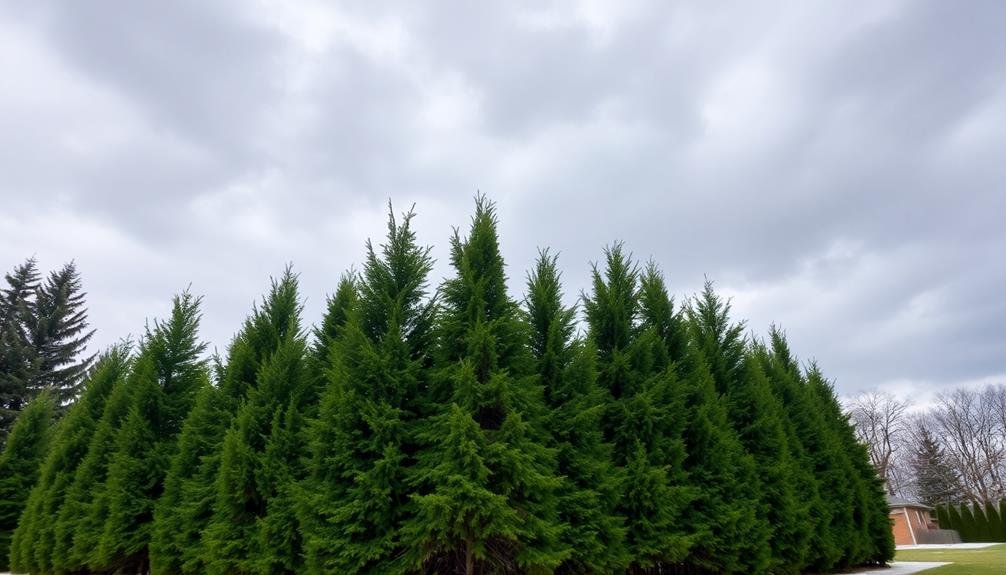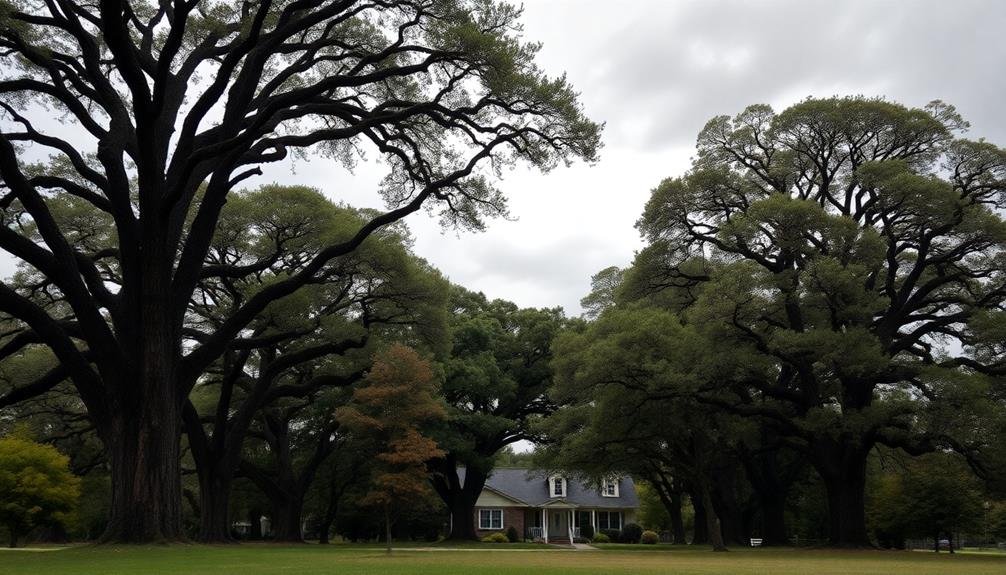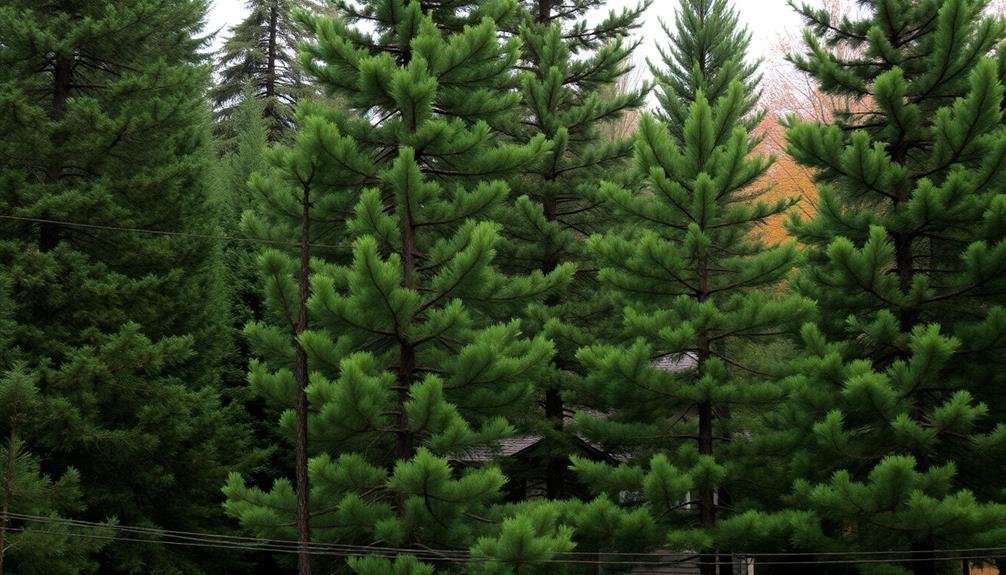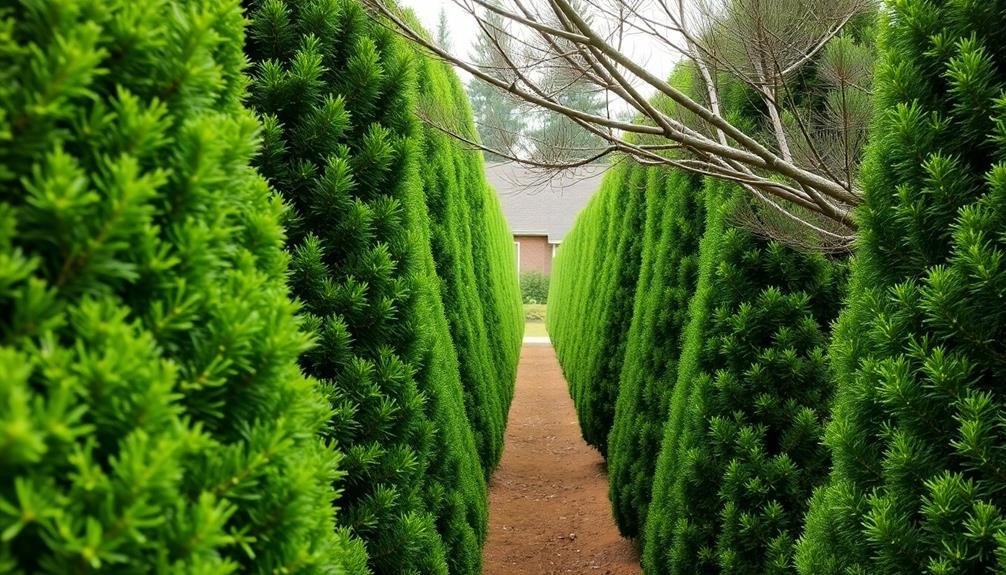You'll dramatically slash wind speeds around your home by strategically planting the right trees as windbreaks. Evergreens like Norway spruce and white pine offer year-round protection with their dense foliage. For seasonal adaptation, consider deciduous trees like maples and oaks. Fast-growing options such as hybrid poplars provide quick results, while native species guarantee long-term resilience. Plant trees in staggered, U-shaped patterns perpendicular to prevailing winds, 50-100 feet from your house. Mix tree types and layer with shrubs for best coverage. With proper placement and species selection, you'll create a living shield that not only blocks wind but also enhances your property's beauty and value.
Evergreen Trees for Wind Barriers

Evergreen trees are consistently the top choice for creating effective wind barriers around homes. They retain their foliage year-round, providing continuous protection against strong winds.
When selecting evergreens for windbreaks, take into account species like Norway spruce, white pine, and arborvitae. These trees grow tall and dense, forming a solid wall that deflects wind.
You'll want to plant your evergreen windbreak in a row or staggered pattern, perpendicular to the prevailing wind direction. Space the trees close enough to create a continuous barrier but far enough apart to allow for healthy growth. As a general rule, aim for a distance of about 6 to 8 feet between trees.
For maximum effectiveness, plant multiple rows of evergreens. This creates a thicker barrier and guarantees continued protection if some trees are damaged or lost.
You can also combine different evergreen species to add visual interest and improve disease resistance. Remember to take into account the mature size of the trees and their growth rate when planning your windbreak.
With proper placement and care, your evergreen wind barrier will provide long-lasting protection for your home.
Optimal Tree Placement Strategies
A homeowner's strategic tree placement can greatly enhance wind protection. To create an effective windbreak, you'll want to plant your trees in a staggered, U-shaped pattern around your home's perimeter. This formation disrupts wind flow and reduces its impact on your property.
Start by identifying the prevailing wind direction in your area. Plant your windbreak perpendicular to this direction, typically on the north and northwest sides of your home. For maximum effectiveness, place trees 50 to 100 feet away from your house, depending on the mature height of the species.
Create multiple rows of trees, spacing them about 10 to 15 feet apart within each row. Stagger the trees between rows to fill any gaps. Use a mix of fast-growing and slow-growing species to guarantee both immediate and long-term protection.
Don't forget to take your home's design into account when placing trees. Avoid planting too close to foundations, utilities, or septic systems.
Also, make sure that your windbreak doesn't block desirable views or winter sunlight. By carefully planning your tree placement, you'll create an effective wind barrier that enhances your home's protection and energy efficiency.
Deciduous Trees as Windbreaks

Deciduous trees offer unique seasonal wind protection for your home.
In summer, their dense foliage creates an effective windbreak, while in winter, their bare branches still slow wind speeds.
You'll find maples, oaks, and elms are popular choices for deciduous windbreaks due to their size and adaptability to various climates.
Seasonal Wind Protection
Why consider deciduous trees for wind protection when they lose their leaves? You might be surprised to learn that these trees offer year-round benefits.
In winter, their bare branches still reduce wind speed by up to 50%, providing significant protection for your home. As seasons change, deciduous trees adapt to your needs, offering dense foliage in summer for maximum wind blockage and allowing sunlight through in winter to warm your home.
Deciduous trees provide dynamic wind protection that evolves with the seasons:
- Spring: New leaves emerge, gradually increasing wind resistance
- Summer: Full canopy offers maximum wind blockage and shade
- Fall: Changing colors add beauty while maintaining wind protection
- Winter: Bare branches continue to disrupt wind patterns
- Year-round: Root systems help stabilize soil and prevent erosion
You'll find that deciduous windbreaks are more flexible than evergreen options.
They're often faster-growing, allowing quicker establishment of your wind barrier. Additionally, deciduous trees typically have a broader root system, making them more stable in high winds.
Popular Deciduous Windbreak Species
Maples, oaks, and elms stand tall among the most popular deciduous trees for windbreaks. These species offer excellent wind protection during the growing season while allowing sunlight to penetrate during winter months.
Maple varieties like sugar and red maples provide dense foliage and grow quickly, making them ideal for windbreaks. Oaks, such as white and red oaks, are known for their strength and longevity, offering robust wind protection for decades.
American elms, once widespread, have been largely replaced by disease-resistant cultivars like the 'Valley Forge' elm. These trees still provide excellent wind blockage and shade.
Other deciduous options include the fast-growing tulip tree, which reaches impressive heights, and the sturdy beech tree, known for its wide-spreading canopy.
When selecting deciduous windbreak trees, consider their mature size, growth rate, and adaptability to your local climate.
Plant them in staggered rows for maximum effectiveness, allowing enough space between trees for proper growth.
Remember that deciduous windbreaks require more width than evergreen barriers to achieve the same level of wind reduction, so plan your layout accordingly.
Fast-Growing Trees for Quick Protection
When you're looking for rapid results in wind protection, fast-growing trees are your best allies. These trees can quickly establish a windbreak, providing shelter for your home in just a few years. Some of the fastest-growing trees suitable for windbreaks include hybrid poplars, willow trees, and eucalyptus species. These trees can grow several feet per year, allowing you to create an effective barrier in a relatively short time.
To maximize the effectiveness of your fast-growing windbreak, consider these key points:
- Plant trees in staggered rows for better wind deflection
- Space trees according to their mature size to avoid overcrowding
- Mix fast-growing species with slower-growing, longer-lived trees for long-term protection
- Choose trees adapted to your local climate and soil conditions
- Implement proper care and maintenance to guarantee healthy growth
While fast-growing trees offer quick results, they often have shorter lifespans and may be more prone to storm damage.
It's crucial to balance your desire for rapid protection with the long-term stability of your windbreak. By combining fast-growing species with more durable, slower-growing trees, you'll create a windbreak that provides both immediate and lasting protection for your home.
Native Species for Wind Resistance

While fast-growing trees offer quick results, native species provide superior long-term wind resistance and ecological benefits.
When selecting trees for wind protection, consider your local climate and soil conditions. Native trees have adapted to these factors over time, making them more resilient and better suited for your area.
In the Northeast, you'll find that sugar maples and white pines excel at blocking wind. They're sturdy and well-adapted to cold winters.
For the Midwest, bur oaks and hackberry trees are excellent choices, withstanding strong prairie winds.
In the South, live oaks and bald cypresses offer robust protection against hurricanes and coastal breezes.
Western regions benefit from native conifers like Douglas firs and ponderosa pines, which create effective windbreaks.
In arid areas, mesquite and desert willow trees provide wind resistance while conserving water.
Dense Foliage and Branch Structure
The key to effective wind protection lies in a tree's dense foliage and intricate branch structure. You'll want to choose trees with year-round leaf coverage and tightly packed branches to create a solid barrier against strong winds. Evergreen trees are often the best choice, as they maintain their wind-blocking abilities throughout all seasons.
When selecting trees for wind protection, consider these factors:
- Leaf density: Look for trees with closely spaced leaves
- Branch arrangement: Opt for trees with multiple layers of branches
- Crown shape: Choose trees with broad, rounded, or pyramidal crowns
- Growth rate: Select fast-growing species for quicker results
- Mature size: Confirm the tree will fit your space when fully grown
You'll find that trees with dense foliage and complex branch structures not only block wind effectively but also provide additional benefits. They can reduce noise pollution, increase privacy, and create a more attractive landscape.
Remember that proper placement is essential for maximizing wind protection. Plant your trees in a staggered formation to create a more effective windbreak, and consider using a mix of different species to enhance resilience against pests and diseases.
Year-Round Wind Protection Solutions

To guarantee your home is shielded from wind year-round, consider planting evergreen tree wind barriers that maintain their foliage throughout all seasons.
You'll benefit from layered windbreak designs, which combine trees of varying heights and densities to maximize wind reduction.
Strategic planting techniques, such as staggering rows and positioning trees at ideal distances from your home, will further enhance the effectiveness of your wind protection.
Evergreen Tree Wind Barriers
Nature's sentinels stand guard year-round when you choose evergreen trees as wind barriers. These steadfast protectors offer constant shielding against harsh winds, maintaining their foliage throughout all seasons.
By strategically planting evergreens, you'll create a living fortress that not only blocks wind but also enhances your property's aesthetic appeal.
When selecting evergreen trees for wind protection, consider:
- Height at maturity
- Growth rate
- Density of branches and foliage
- Tolerance to local climate conditions
- Root system characteristics
Popular evergreen choices include Norway spruce, Eastern white pine, and Leyland cypress. These species grow tall and dense, forming an effective barrier against prevailing winds.
You'll want to plant them in a staggered double or triple row for maximum effectiveness.
Keep in mind that evergreens require proper spacing to thrive and maintain their wind-blocking capabilities. As they mature, they'll create a more robust barrier, improving your home's energy efficiency and outdoor comfort.
Regular maintenance, including pruning and fertilizing, will guarantee your evergreen wind barrier remains healthy and effective for years to come.
Layered Windbreak Designs
Layered windbreak designs offer a thorough approach to year-round wind protection for your property. These designs incorporate multiple rows of trees and shrubs to create a more effective barrier against wind. You'll want to plant at least three rows, with each row serving a specific purpose.
Start with a row of dense evergreens as your primary windbreak. This could include trees like Norway spruce or arborvitae. Behind this, plant a row of deciduous trees that grow taller than the evergreens. Options like oak or maple work well here.
Finally, add a row of shorter shrubs or small trees to fill any gaps and provide additional wind reduction.
When planning your layered windbreak, consider the mature height and spread of each species. Space the rows appropriately to allow for growth and maintenance. Plant trees in a staggered pattern across rows to maximize coverage.
Remember to leave some space between the windbreak and your home for air circulation and to prevent potential damage from falling branches. With proper planning and maintenance, a layered windbreak design will provide superior wind protection for your home throughout the year.
Strategic Planting Techniques
How can you maximize the effectiveness of your windbreak through strategic planting? Start by evaluating the prevailing wind direction in your area and plan your tree layout accordingly. You'll want to create a dense barrier perpendicular to the wind's path.
Plant your trees in staggered rows to eliminate gaps and guarantee all-encompassing coverage. It's essential to space your trees properly, allowing enough room for mature growth while maintaining a tight formation.
To enhance your windbreak's performance, reflect on these key strategies:
- Combine fast-growing and slow-growing species for immediate and long-term protection
- Incorporate evergreens for year-round wind blockage
- Use deciduous trees on the windward side to slow wind before it reaches the evergreens
- Plant shrubs between trees to fill lower-level gaps
- Include trees with varying heights to create a stepped effect, gradually lifting the wind
Remember to account for your home's location and landscaping features when designing your windbreak.
You'll also want to take into account the mature size of each tree species to avoid overcrowding or interference with utilities.
Layered Windbreak Design Techniques
An effective windbreak design often incorporates multiple layers of trees and shrubs to maximize protection.
You'll want to start with a row of dense, evergreen trees as your primary windbreak. Plant these tallest trees perpendicular to the prevailing wind direction, typically on the north and west sides of your property.
Behind this main row, add a second layer of shorter evergreen trees or tall shrubs. This creates a stepped effect that helps redirect wind upward and reduces turbulence.
For the third layer, incorporate deciduous trees or lower-growing shrubs. These add depth to your windbreak and provide additional wind filtration.
Consider including a row of dense shrubs closest to your home as a final layer. This helps trap snow and debris before they reach your living areas.
Space your plantings carefully, allowing room for growth while maintaining a continuous barrier. You'll typically want to leave gaps of about 4-5 feet between trees in each row, with rows spaced 15-20 feet apart.
Remember to stagger your plantings between rows for better coverage and a more natural appearance.
Coniferous Trees for Maximum Effectiveness

When planning your windbreak, you'll find coniferous trees offer unbeatable year-round protection.
These evergreens maintain their dense foliage throughout all seasons, providing consistent wind blockage.
You'll benefit from their thick branches and needles, which create an effective barrier against strong gusts and help reduce wind speed around your home.
Evergreen Windbreak Strategies
For maximum wind protection, evergreen coniferous trees are your best bet when creating a windbreak around your home. These trees maintain their foliage year-round, providing consistent shelter from harsh winds.
When planning your evergreen windbreak, consider the following strategies to optimize its effectiveness:
- Plant trees in staggered rows to create a denser barrier
- Space trees closer together for immediate protection, thinning as they mature
- Combine fast-growing and slow-growing species for long-term sustainability
- Include a mix of heights to block wind at various levels
- Extend the windbreak beyond the area you want to protect for better coverage
You'll want to position your windbreak perpendicular to prevailing winds, typically on the north and west sides of your property.
The ideal distance from your home is about 2-5 times the mature height of the trees. This allows for snow accumulation and prevents damage to your house from falling branches.
Remember to account for mature tree size when planting near structures or power lines.
Dense Foliage Advantages
Coniferous trees' dense foliage offers unparalleled advantages for wind protection around your home. These evergreen giants create a year-round barrier that effectively reduces wind speed and turbulence. Their thick, needle-like leaves and tightly packed branches form a solid wall of greenery that can deflect and disperse strong gusts.
You'll find that conifers like spruce, pine, and fir trees are particularly effective at blocking wind due to their conical shape and closely spaced branches. This structure allows them to withstand high winds while minimizing gaps in coverage. As they grow, these trees become even more efficient windbreakers, providing increasingly robust protection for your property.
The dense foliage of conifers also offers additional benefits beyond wind blockage. They can help reduce noise pollution, increase privacy, and create microclimates that moderate temperature extremes around your home.
Windbreak Height and Spacing Considerations
Taking into account the essential factors of windbreak design, height and spacing play pivotal roles in determining effectiveness.
When planning your windbreak, aim for trees that'll grow to at least 30 feet tall. Taller trees provide better wind protection over a larger area. As a general rule, a windbreak can reduce wind speeds for a distance of up to 30 times its height.
Spacing is equally important. Plant your trees close enough to form a solid barrier, but not so close that they compete for resources. For most species, spacing of 6 to 8 feet apart is ideal. Remember to keep in mind the mature size of the trees when planning.
Key considerations for windbreak height and spacing:
- The taller the windbreak, the larger the protected area
- Multiple rows increase effectiveness but require more space
- Deciduous trees need closer spacing than evergreens
- Allow room for equipment access for maintenance
- Reflect on the impact on views and sunlight for your property
Maintenance of Wind-Blocking Trees

While establishing a windbreak is a crucial first step, maintaining your wind-blocking trees guarantees their long-term effectiveness and health.
Regular pruning is important to promote strong branch structure and remove dead or diseased limbs. You'll need to prune deciduous trees annually and evergreens every few years.
Water your windbreak trees deeply and consistently, especially during their first few years and in dry periods.
Fertilize your trees as needed, based on soil tests and visible signs of nutrient deficiency.
Mulch around the base of each tree to retain moisture and suppress weed growth.
Monitor for pests and diseases regularly, and take prompt action if you spot any issues.
Replace any trees that die or become severely damaged to maintain the windbreak's integrity.
As your windbreak matures, you may need to thin out some trees to prevent overcrowding. This guarantees proper air circulation and sunlight penetration.
Finally, keep an eye on the overall shape and density of your windbreak, adjusting as necessary to maintain its wind-blocking effectiveness.
With proper care, your windbreak will provide long-lasting protection for your home.
Climate-Specific Tree Selection Guide
Choosing the right trees for your wind-blocking strategy depends heavily on your local climate. You'll need to evaluate factors like temperature ranges, precipitation levels, and soil types to select trees that will thrive in your area while effectively blocking wind.
For cold climates, evergreen conifers like spruce and pine are excellent choices, as they provide year-round protection. In warmer regions, you might opt for broadleaf evergreens or deciduous trees with dense canopies.
Examine these climate-specific tree options:
- Cold climates: Norway Spruce, White Pine, Arborvitae
- Temperate zones: Red Oak, Sugar Maple, American Beech
- Hot and dry areas: Live Oak, Eucalyptus, Leyland Cypress
- Coastal regions: Sea Buckthorn, Monterey Cypress, Salt Cedar
- Urban environments: Ginkgo, Honey Locust, Japanese Zelkova
When selecting trees, also factor in their mature size, growth rate, and resistance to pests and diseases common in your area.
Native species are often the best choice, as they're already adapted to local conditions. Don't forget to check with local gardening experts or extension offices for specific recommendations tailored to your region's unique climate challenges.
Combining Trees With Other Windbreak Elements

To maximize the effectiveness of your windbreak, you'll want to combine trees with other elements. Consider incorporating shrubs and hedges alongside your trees to create a multi-layered barrier. These smaller plants can fill gaps between trees and provide additional wind protection closer to ground level.
Don't overlook the potential of fencing and walls as complementary windbreak components. A solid fence or wall can offer immediate wind protection while your trees mature. Place these structures strategically to work in tandem with your tree plantings.
Berms and earthen mounds can also enhance your windbreak's performance. By elevating your trees on a gentle slope, you'll increase their ability to deflect wind upward and away from your home.
Consider adding non-living elements like trellises or lattice panels to your windbreak design. These structures can support climbing plants or vines, creating an additional wind-blocking layer while adding visual interest to your landscape.
Lastly, don't forget about hardscaping elements. Strategically placed boulders or rock formations can help disrupt wind patterns and provide localized protection for smaller plants or outdoor living areas.
Frequently Asked Questions
How Long Does It Take for Newly Planted Trees to Become Effective Windbreaks?
You'll need patience for newly planted trees to become effective windbreaks. It typically takes 5-10 years for them to grow tall and dense enough to provide significant wind protection. Faster-growing species may offer some benefits sooner.
Can Wind-Blocking Trees Affect My Home's Natural Light and Solar Panel Efficiency?
Yes, wind-blocking trees can impact your home's natural light and solar panel efficiency. You'll need to carefully plan tree placement to balance wind protection with sun exposure. Consider deciduous trees for seasonal light changes and consult a professional for ideal positioning.
Are There Any Trees That Should Be Avoided for Wind Protection?
You should avoid fast-growing, weak-wooded trees like silver maples and willows for wind protection. They're prone to breakage in strong winds. Also, steer clear of invasive species that could spread uncontrollably and cause ecological issues in your area.
How Do Wind-Blocking Trees Impact Local Wildlife and Ecosystems?
You'll find wind-blocking trees provide shelter and habitat for various animals. They can create microclimates, affecting local temperature and humidity. However, they may also disrupt existing ecosystems if they're non-native species or planted in large numbers.
What Are the Potential Drawbacks or Risks of Planting Trees for Wind Protection?
You'll face potential drawbacks when planting trees for wind protection. They can block sunlight, interfere with utilities, and damage foundations. Fallen branches pose safety risks, and some species may attract pests or cause allergies. Maintenance costs can increase too.
In Summary
You've now got a thorough guide to selecting and planting the best trees for wind protection. Remember, it's not just about choosing the right species but also considering placement, spacing, and maintenance. By combining evergreens, deciduous trees, and fast-growing varieties, you'll create an effective windbreak tailored to your climate. Don't forget to incorporate native species and other landscaping elements for ideal results. With proper planning, you'll soon enjoy a more sheltered and comfortable home environment.





Leave a Reply